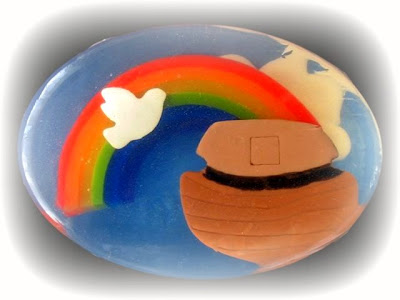Thursday, September 29, 2011
The Spark of Life
Noah's Ark, in the shower.

This piece of visual art was hand crafted by Shari Brown. After being inspired by god, Shari came up with the idea of Pure Heart Soaps to spread a “pure heart and a steadfast spirit.” These soaps are all natural, made of vegetable glycerin and natural colors- even the 3 layers of art underneath. Pure Heart Soaps even last longer than most bar soaps; one bar lasts about two months. Shari currently sells her soaps on her website www.pureheartsoaps.com, and a regular bar averages between 7-10$ each.
The thing that stood out to me the most about this bar of soap is that it is more or less directed towards children. Of course, a small child could not order the bar of soap itself online; it would recieve it as a present from a religous aunt or grandmother. As I’ve mentioned before, it still really irks me that the Noah’s Ark story is told as a children’s story. Really, none of the stories in Genesis seem like stories that innocent little Christian and Jewish children should read so mainstream. I mean, this is such a widely known story now, that it has even made it’s way on to a bar of enviormentally friendly soap. I think the artist wanted a way to display her love and gratitude towards god through something kind of innovative, something unique that could both represent her ove for god and make her money. Of course, since it’s a bar of soap, she can’t go into great detail on the pictures; she has to get her message across through cute, simple images made of glycerin that will appeal to both children and adults. (A lot of her other soaps feature ponies and flowers and autumn leaves.)
It seems that the image of the dove coming back to Noah in the ark is the most widely used because it is the part of the rather grotesque story that symbolizes new life and hope. I don’t think that Shari would ever put drowned bodies in a massive flood of the earth on a cutesy little bar of soap.
Wednesday, September 28, 2011
Cain and Abel Depicted
Genesis... on Acid?
Michelangelo's Sistine Chapel
Cain and Abel
Scarlatti, commonly known as the father of Domenico (a gifted composer of the generation to come), was recognized for his exceptional ability to create pieces for his singers and instrumentalists fostering depth and intellectual expansion. His career really gained momentum in the early sixteenth century. Along his way of becoming an international sensation, Scarlatti composed an oratorio based on the biblical story of Genesis. He titled it “Il Primo Omicidio” otherwise known as “The First Homicide.” The photo above is “a detail from the ‘Ghent Altarpiece’ and the pivotal moment between Cain and Abel” wherein Cain is the world’s first known murderer and Abel is the first known to be murdered.
As the story goes, Eve first gives birth to Cain, and later gives birth to Abel. Abel became a shepherd. Cain became a farmer. Abel offered God a lamb. Cain offered God crops. Abel was favored in Gods eyes. Envious of his brother’s distinctiveness and importance in the eyes of God, Cain led his brother out to the fields and slayed him. Scarlatti’s oratorio is described as being equipped with “accompaniments to capture temperaments that ranged from fierce hostility to heartbreaking pain.” And this “Ghent altarpiece”, or panel painting, used in the performance is an artwork depicting exactly that. Clearly, as Cain is shown towering over Abel with one hand clenching a weapon raised above his head and the other hand compressing the neck of the brother the weapon will surely come down upon, he represents malevolent impulses, enmity, deep-seated bitterness, and ill will. And Abel, his face filled with distress and suffering as he is forcefully confined to the ground at the hands of his belligerent brother, represents sorrow, anguish, despair.
In my opinion, the artist captured the story in all its meaning fairly well. If I had to produce for you the artists’ limitations I would surely have to make one up because I believe the photo depicts Genesis’ Abel and Cain accurately to the core and gave inspiring significance and meaning to it.
Tuesday, September 27, 2011
The Flood
One minor detail that stands out for me in the painting is in the background on Noah’s Ark. It seems that there is actually a person swinging an ax at a straggler attempting to climb aboard. I believe at the man right above the ax wielder is Noah motioning him to not harm the straggler. Also on the smaller boat in the center of the painting there is a person being bludgeoned and pushed off. I was particularly surprised by the graphic violence depicted in the fresco. When I think of the story of Noah’s Ark do not automatically think of the actual scramble and chaos which must have been present at the time. I guess it is in our nature to block out the bad aspects of things and think of only the good, which I why I found the fresco to be a truly realistic depiction of the story. I believe Michelangelo intended for his portrayal to be as realistic as possible and in my opinion he was successful in doing so. He is showing mankind being punished for all of its bad deeds which is what the intended message of the story is. I do not think Michelangelo had many limitations when creating this art in terms of his supplies or medium. However, he was limited in terms of what stories from the Book of Genesis he could paint considering the Pope chose them.
